Esketamine Treatment Monitoring Calculator
Treatment Safety Assessment
Monitoring Results
Dissociation Timeline
Peak effect typically occurs at 40 minutes after dosing. Most patients report significant resolution within 1.5-2 hours.
Blood Pressure Risk
Estimated systolic increase: 18 mmHg
Projected BP after dosing: 158 mmHg
Treatment Eligibility
Eligible for Spravato treatment: Yes
Monitoring requirements: 2-hour observation period
When treating treatment-resistant depression (TRD), clinicians now have a fast‑acting option that works very differently from traditional pills. Esketamine nasal spray can lift a severe mood slump in hours, but it also brings a unique safety profile - most notably dissociation, a quick rise in blood pressure, and a set of strict monitoring steps that feel more like a cardiac stress test than a routine prescription.
What is Esketamine nasal spray?
Developed by Janssen Pharmaceuticals, the nasal spray (brand name Spravato) received FDA approval in March 2019 as the first glutamatergic antidepressant on the market. Unlike SSRIs that boost serotonin, esketamine blocks the NMDA receptor - a key gateway for glutamate signals in the brain. By dampening NMDA activity on GABA‑interneurons, the drug releases a burst of excitatory firing that appears to reset mood circuits within minutes.
Why does dissociation happen?
The same mechanism that lifts mood can also unplug the brain’s sense of reality. In the three pivotal Phase 3 trials (TRANSFORM‑1, 2, 3), about 56 % of patients reported a feeling of unreality, floating, or time distortion - symptoms clinicians label “dissociation.” Most of those episodes peaked at roughly 40 minutes after the spray and faded in the next 60‑90 minutes. Severe cases (CADSS score ≥ 3) were rare, occurring in just 6 % of participants.
“Dissociation feels like being in a dream you can’t quite control,” says one patient on a popular forum. That description matches the Clinical Administered Dissociative States Scale (CADSS) - a 23‑item questionnaire that clinicians use before, during, and after dosing to quantify how detached a person feels.
Blood pressure spikes - what to expect?
Within five minutes of the spray, the sympathetic nervous system gets a jolt, pushing systolic pressure up 14‑23 mmHg on average. In pooled trial data, 33 % of patients crossed the 140 mmHg threshold, compared with 14 % of placebo‑treated participants. The rise is usually short‑lived, returning to baseline by the two‑hour mark, and most patients feel fine - they just get a quick reminder to stay still and breathe.
People with uncontrolled hypertension (systolic > 160 mmHg) are screened out before treatment, and clinics keep emergency meds and oxygen on hand in case a spike turns symptomatic.
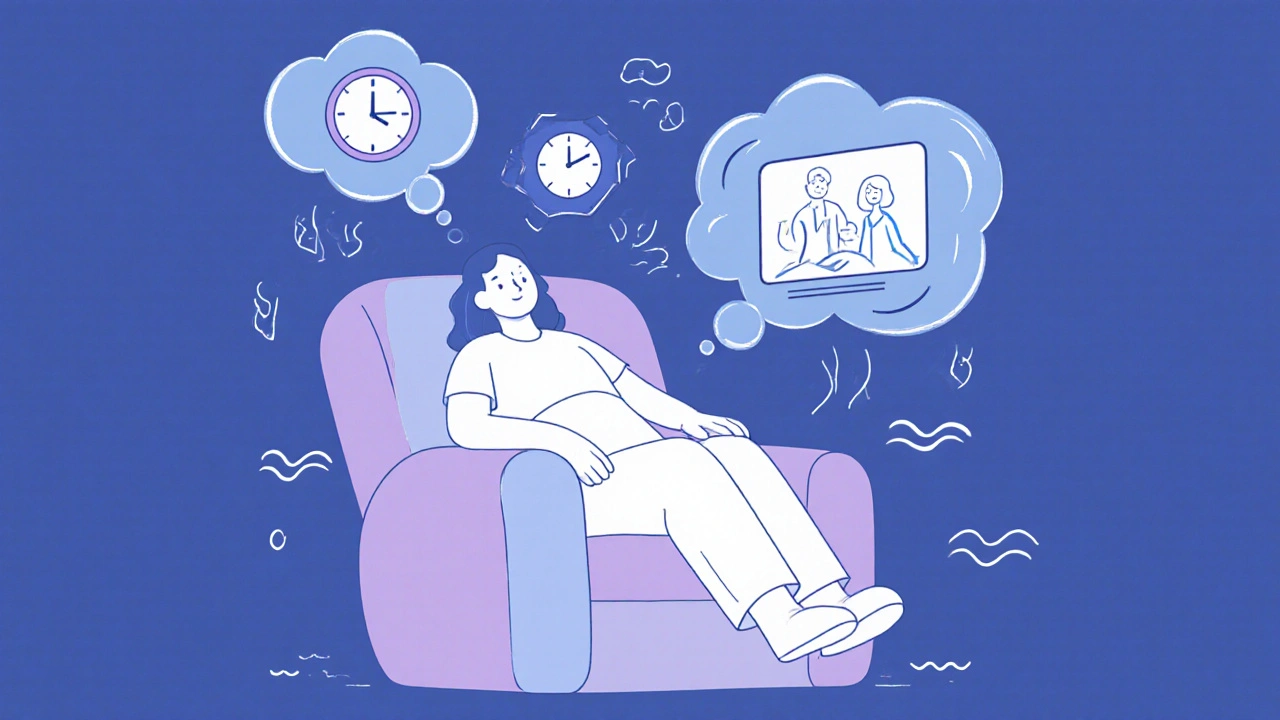
How the REMS program shapes every treatment visit
The FDA’s Risk Evaluation and Mitigation Strategy (REMS program) is the backbone of safety for esketamine. It forces three things:
- Administration only in certified centers that have trained staff and resuscitation equipment.
- Pre‑dose checks: blood pressure, heart rate, mental status, and a quick CADSS baseline.
- A mandatory two‑hour post‑dose observation period, during which vitals are taken every 5‑10 minutes for the first 40 minutes, then every 15‑30 minutes.
At the end of the session, the patient signs a “Patient‑Provider Agreement” that repeats the key risks and confirms they understand the monitoring steps.
Step‑by‑step monitoring checklist
| Time Point | Action | Key Metrics |
|---|---|---|
| ‑15 min | Pre‑dose assessment | BP, HR, CADSS baseline, consent |
| 0 min | Administer dose (28‑84 mg) | Observe for immediate reactions |
| 5‑10 min | First vitals check | BP, HR, O2 sat |
| 20‑40 min | Peak‑effect window | CADSS assessment, repeat BP |
| 60‑90 min | Recovery check | Symptom check, BP trending toward baseline |
| 120 min | Discharge readiness | Stable vitals, CADSS < 10, patient cleared |
Practical tips for clinicians
- Set the scene. Dim lights, soft music, and a quiet room lower anxiety and make any dissociative episode feel less “out‑of‑control.”
- Use a visual timer. Let the patient see a countdown so they know when the peak period ends.
- Have rescue meds ready. Benzodiazepines (e.g., lorazepam) are on standby, but they’re needed in less than 2 % of cases.
- Document every vital. Electronic monitoring systems that flag BP > 150 mmHg automatically reduce human error.
- Screen for cardiovascular risk. A quick EKG isn’t required, but a recent BP reading within the past 30 days helps decide eligibility.
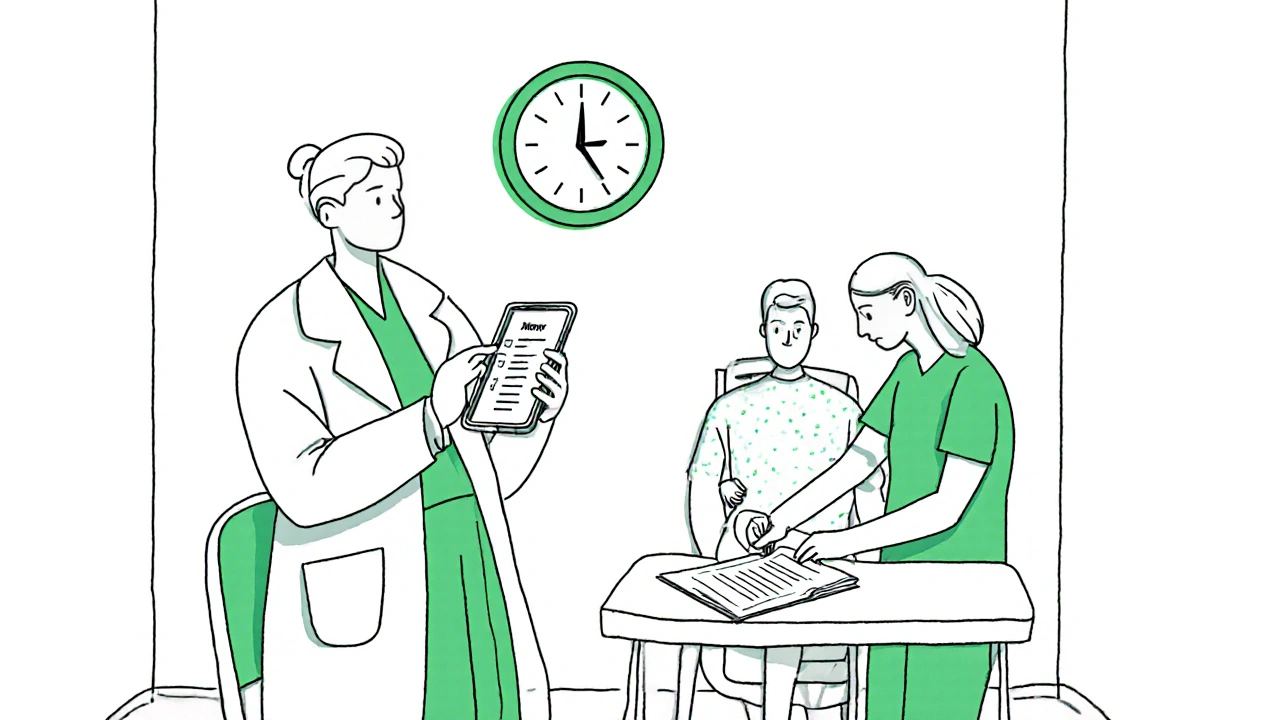
What patients should know before their first spray
Expect to spend about 2 hours at the clinic. Bring a light snack, wear comfortable clothes, and arrange transportation - you shouldn’t drive for at least four hours after dosing. Most people describe the dissociative feeling as “like watching a movie of your life.” It’s unsettling at first, but the sensation usually fades as the session ends. If you have a history of high blood pressure, let the clinical team know; they may adjust the dose or schedule extra vitals checks.
Future directions - can monitoring get easier?
Recent data from the SUSTAIN‑2 trial suggests that a subset of stable patients could be cleared after just one hour of observation, cutting the clinic time by 33 %. Digital health startups are also piloting remote CADSS‑like questionnaires delivered via tablet or smartphone, feeding real‑time scores to the clinic nurse. Even with tech, the FDA’s REMS committee keeps warning that the core safety concerns - sudden BP spikes and dissociation - are intertwined with the drug’s mechanism. So a brief “watch‑only” period will likely stay in place for the foreseeable future.
Bottom line
Esketamine nasal spray offers a rapid lifeline for people stuck in treatment‑resistant depression, but it does so at the cost of a short‑term reality break and a quick rise in blood pressure. The good news? Those side effects are predictable, time‑limited, and manageable when clinics follow the REMS‑driven monitoring checklist. For providers, having a solid protocol and a calm treatment environment makes the difference between a smooth session and a crisis.
How long does dissociation usually last after a Spravato dose?
Most patients feel the peak around 40 minutes, and the feeling fades within 1.5‑2 hours. Severe dissociation (CADSS ≥ 3) typically resolves in the same window.
Is it safe to take esketamine if I have high blood pressure?
Patients with uncontrolled hypertension (systolic > 160 mmHg) are screened out. Those with well‑managed BP can still receive the drug, but clinics monitor vitals every 5‑10 minutes during the first hour.
Do I need a caregiver to stay with me after treatment?
Yes. A responsible adult must remain with you for the full monitoring period because transient cognitive changes can affect judgment.
Can the monitoring time be shortened?
For patients who show stable vitals and low CADSS scores after the first hour, some certified centers now discharge after 60 minutes, based on the SUSTAIN‑2 data.
What should I do if I feel a panic attack during dissociation?
Tell the clinic staff immediately. They’ll lower the lights, offer a calming voice, and, if needed, give a low dose of lorazepam. Most episodes settle on their own once the drug’s peak passes.

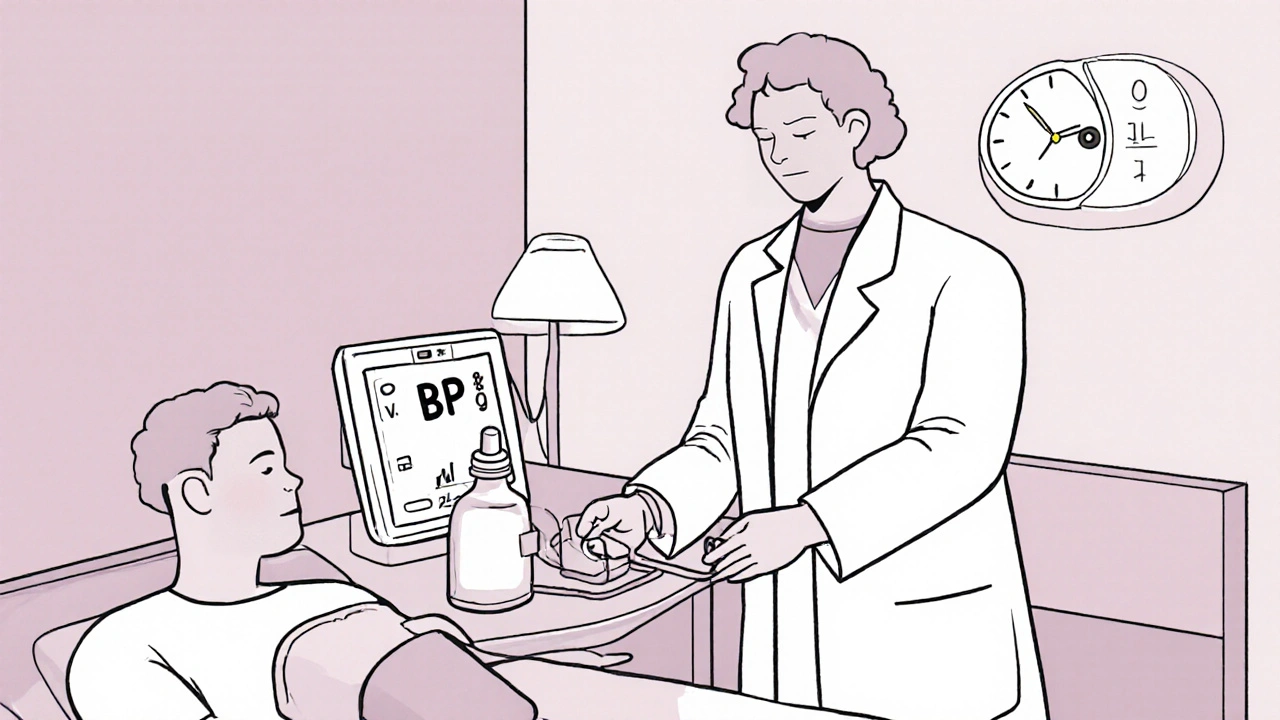

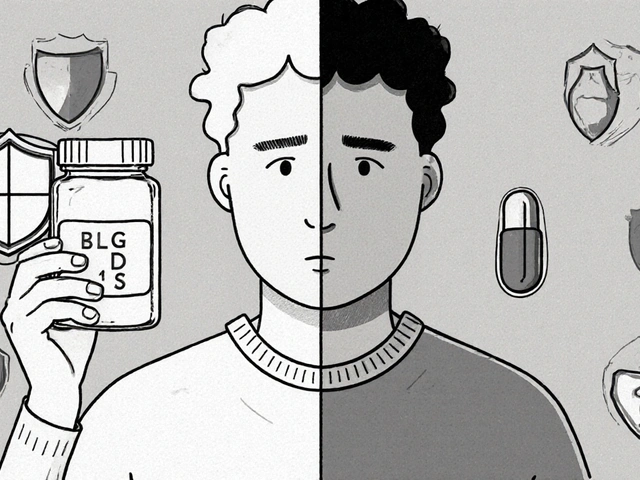

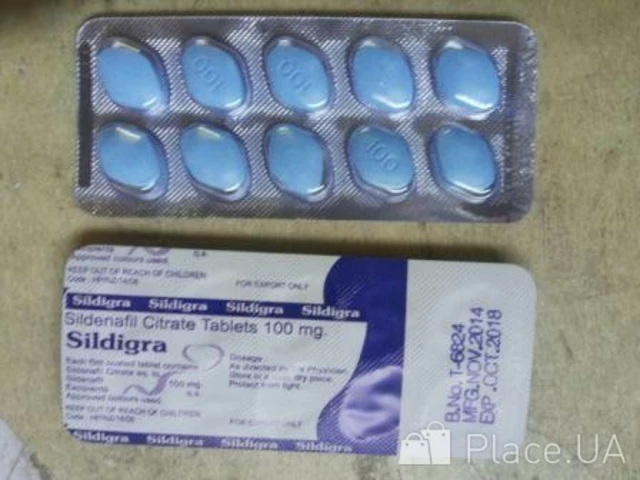
Samantha Taylor
While the REMS protocol reads like a bureaucratic novella, the reality is that most clinics can follow it with a simple checklist. The inevitable dissociation is, as you noted, a “dream you can’t control,” which, frankly, sounds like an invitation to a therapeutic adventure rather than a side effect. Of course, any rise in systolic pressure is merely the body’s polite applause for a novel pharmacologic trick. So, if you enjoy ticking boxes and watching blood pressure spikes, you’ll find Spravato delightfully predictable.
Joe Langner
Hey folks, I think it’s great that we have a fast‑acting option – it gives hope when other meds just sit there like stubborn weeds. The whole monitoring thing might seem overkill, but think of it as a short‑term safety net; we’re all in this together, right? If you stay calm and focus on breathing, tihs will pass faster than a bad Netflix binge. Just remember, every 5‑minute check is a chance to celebrate a tiny victory, so keep that optimism alive!
Ben Dover
The procedural rigor described is unsurprising given FDA mandates.
Ben Durham
From a practical standpoint, using a visual timer not only reduces anxiety but also gives patients a concrete reference point during the peak window. Ensuring the room is dimly lit and playing soft background music can significantly lower the subjective intensity of dissociation, which aligns with the cultural emphasis on patient comfort. Documenting vitals in an electronic system with automated alerts for BP >150 mmHg further minimizes human error while respecting the clinic’s workflow.
Tony Stolfa
Look, the whole “two‑hour observation” saga is just a cash‑grab masquerading as patient safety. If you can handle a 15‑mmHg spike, you don’t need a nurse monitoring you like a lab rat. These clinics love to boast about “rigorous protocols” while they secretly pad their billable hours. Enough with the paternalistic nonsense – the drug works, the side effects are transient, and the bureaucracy can go take a hike.
Joy Dua
Oh dear the dance of NMDA blockade is a flamboyant waltz of neurochemistry that briefly ejects consciousness from its mundane shackles while the heart decides to throw a modest celebration of pressure.
Holly Kress
I appreciate the thorough breakdown of the monitoring steps; it really helps demystify what can feel overwhelming for new patients. Keeping a caregiver present is not just a regulatory box but a compassionate safety net, especially if a brief panic episode sneaks in during dissociation. Remember, the goal is to return to baseline both mentally and physiologically, and the outlined timeline supports that aim nicely.
Charlene Gabriel
When I first read about Spravato, I was both intrigued and a little intimidated by the sheer amount of monitoring required.
However, as I dug deeper, I realized that each step is designed with the patient’s well‑being in mind, which is ultimately reassuring.
The pre‑dose assessment, although thorough, serves as an opportunity for clinicians to connect with patients and address any lingering concerns.
Seeing the blood pressure and heart rate recorded every few minutes might feel like an interrogation, but it also provides real‑time reassurance that the body is handling the medication safely.
The dissociation, often described as watching a movie of one’s life, can be unsettling; yet, with a calm environment-soft lighting, gentle music, and a supportive staff-the experience becomes a guided exploration rather than a frightening loss of control.
From a philosophical standpoint, this temporary shift in consciousness can actually open a window for patients to observe their thoughts from a new perspective, which many find therapeutic in itself.
Moreover, the two‑hour observation period, while seemingly lengthy, gives the clinical team ample time to intervene with a low dose of lorazepam if needed, ensuring that no one feels abandoned during the peak effect.
The checklist presented in the article is remarkably clear, and following it can turn a potentially chaotic session into a well‑orchestrated routine.
I’ve heard stories from patients who, after their first spray, felt a gentle lift in mood that persisted for days, confirming the rapid‑acting nature of esketamine.
It’s also encouraging to see emerging data suggesting that, for stable patients, the monitoring window could be safely reduced, which would make the whole process more accessible.
Digital tools, such as tablets for quick CADSS assessments, are a wonderful innovation that respects both time and patient comfort.
Of course, it remains essential that clinics retain the core safety checks, as the intertwining of blood pressure spikes and dissociative effects is physiologically inevitable.
Nevertheless, the flexibility to tailor the dosage and observation length based on individual response is a testament to the personalized approach of modern psychiatry.
For clinicians, creating a welcoming space-perhaps with a cozy chair and a calming scent-can significantly diminish anxiety and improve overall outcomes.
Patients should also remember to arrange transportation and a caregiver, which not only satisfies regulatory requirements but also fosters a sense of community support.
In summary, while Spravato demands diligence, its potential to rapidly alleviate treatment‑resistant depression makes the effort worthwhile for both providers and those they care for.
Gary Campbell
What most people don’t realize is that the rapid approval of Spravato coincided with a silent partnership between several big‑pharma conglomerates and regulatory insiders, effectively bypassing the deeper scrutiny that a drug altering NMDA transmission truly deserves.